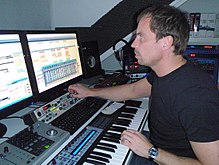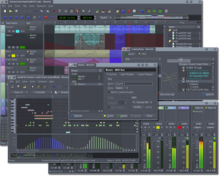Digital audio workstation
This article needs additional citations for verification. (January 2017) |

A digital audio workstation (DAW
DAWs are used for producing and recording
Hardware
Early attempts at digital audio workstations in the 1970s and 1980s faced limitations such as the high price of storage, and the vastly slower processing and disk speeds of the time.
In 1978,
By the late 1980s, a number of personal computers such as the
In 1989,
Many major
In 1992, Sunrize Industries released the AD516 soundcard for big-box Amiga computers.[5] This allowed up to 8 tracks of 16-bit 48 kHz direct-to-disk recording and playback using its Studio 16 software. It could also integrate directly into Blue Ribbon Soundworks' Bars & Pipes Pro MIDI software or NewTek's Video Toaster, thus providing a complete package of MIDI sequencing and/or video synchronization with non-linear hard disk recording.
In 1993, the German company
In 1994, a company in California named OSC produced a 4-track editing-recorder application called DECK that ran on Digidesign's hardware system, which was used in the production of The Residents' Freakshow [LP].[citation needed]
Integration
An integrated DAW consists of a digital signal processing, control surface, audio converters, and data storage in one device. Integrated DAWs were popular before commonly available personal computers became powerful enough to run DAW software. As personal computer power and speed increased and price decreased, the popularity of costly integrated systems dropped.
Software

"DAW" can refer to the software itself, but traditionally, a computer-based DAW has four basic components: a computer, a sound card or other audio interface, audio editing software, and at least one user input device for adding or modifying data. This could be as simple as a mouse and keyboard or as sophisticated as a piano-style MIDI controller keyboard or automated audio control surface for mixing track volumes.[6]
The computer acts as a host for the sound card, while the software provides the interface and functionality for audio editing. The sound card typically converts analog audio signals into a digital form, and digital back to analog audio when playing it back; it may also assist in further processing of the audio. The software controls all related hardware components and provides a user interface to allow for recording, editing, and playback.
Computer-based DAWs have extensive recording, editing, and playback capabilities (and some also have video-related features). For example, they can provide a practically limitless number of tracks to record on, polyphony, and virtual synthesizers or sample-based instruments to use for recording music. DAWs can also provide a wide variety of effects, such as reverb, to enhance or change the sounds themselves.
Simple smartphone-based DAWs, called mobile audio workstation (MAWs), are used (for example) by journalists for recording and editing on location.
As software systems, DAWs are designed with many
Single-track DAWs display only one (
Perhaps the most significant feature available from a DAW that is not available in analog recording is the ability to undo a previous action, using a command similar to that of the undo function in word processing software. Undo makes it much easier to avoid accidentally permanently erasing or recording over a previous recording. If a mistake or unwanted change is made, the undo command is used to conveniently revert the changed data to a previous state. Cut, Copy, Paste, and Undo are familiar and common computer commands and they are usually available in DAWs in some form. More common functions include the modifications of several factors concerning a sound. These include wave shape, pitch, tempo, and filtering.
Commonly DAWs feature some form of mix automation using procedural line segment-based or curve-based interactive graphs. The lines and curves of the automation graph are joined by or comprise adjustable points. By creating and adjusting multiple points along a waveform or control events, the user can specify parameters of the output over time (e.g., volume or pan). Automation data may also be directly derived from human gestures recorded by a control surface or MIDI controller.
MIDI recording, editing, and playback is increasingly incorporated into modern DAWs of all types, as is synchronization with other audio or video tools.

There are many free and open-source software programs that perform DAW functions. These are designed to run on a variety of operating systems and are usually developed non-commercially.
Personal Composer created by Jim Miller for Yamaha was the star of the NAMM Show in 1983.[7][8] Personal Composer runs under MS DOS 2.0 and includes a MIDI sequencer, synth editor (such as Yamaha's DX7), universal librarians and a score editor. The software was later released as Personal Composer System/2 (1988).[9]
In 1996, Steinberg introduced a revamped Cubase (which was originally launched in 1989 as a MIDI sequencing software for the Atari ST computer, later developed for Mac and Windows PC platforms, but had no audio capabilities until 1993's Cubase Audio) which could record and play back up to 32 tracks of digital audio on an Apple Macintosh without the need of any external DSP hardware.
Digital audio applications for
- it concentrates more on sound manipulation and management than discrete events and sequencing.
- notation editor, and MIDIsupport.
- The MusE sequencer is a similarly featured audio application that includes an audio mixer and a music sequencer.
- Dylan Tallchief created a DAW in Microsoft Excel.[relevant?] The project is available for free download.[10]
Other open-source programs include
Members of the Linux Audio Development (LAD) mailing list have contributed to development of standards such as the LADSPA, DSSI and LV2 plugin architectures. The Virtual Studio Technology (VST) plugin standard is supported by some programs.[11]
Sequencers offer a subset of DAW functionality. Several open-source sequencer projects exist, such as:
Plug-ins
There are countless software plugins for DAW software, each one coming with its own unique functionality, thus expanding the overall variety of sounds and manipulations that are possible. Each have their own form of generating or manipulating sound, tone, pitch, and speed of a simple sound and transform it into something different. To achieve an even more distinctive sound, multiple plugins can be used in layers, and further automated to manipulate the original sounds.
Generative Audio Workstations
Recent developments in generative artificial intelligence are spurring innovation in DAW software. A research paper from Georgia Tech, titled Composing with Generative Systems in the Digital Audio Workstation, proposed the term Generative Audio Workstation to describe this emerging class of DAWs.[12]
Three examples of notable GAWs are AIVA, WavTool, and Symphony V. AIVA provides parameter-based AI MIDI song generation within a DAW. WavTool offers a browser DAW equipped with a GPT-4 composition assistant and AI text-to-sample generator. Symphony V provides generative vocal synthesis, note editing, and mixing tools.[13]
Generative AI services have also become available through plugins that integrate with conventional DAWs, such as Izotope Neutron 4, TAIP, and Synthesizer V. Neutron 4 includes a "mix assistant" that uses machine learning to analyze audio and automatically apply processing effects. TAIP provides tape saturation powered by AI neural networks that imitate traditional DSP processing. Synthesizer V offers several AI vocalists whose notes can be manipulated.[14]
To reduce the strain on computer memory, some plugin companies have developed thin client VSTs that use resources from a cloud server. For example, the audio-to-midi plugin Samplab offers a desktop application with user authentication and API calls that perform stem separation and MIDI transcription off of the computer's local device.[13] This can improve load speeds or prevent applications from crashing.
Impact
DAWs can be implemented in a music education class to show kids how to use them and learn how to produce their own music. According to a study done by the Indonesia University of Education, the use of a DAW in music learning can let students build their learning of music production on their own.[15] Another study done by the University of Milan made a DAW accessible to kids.[16]
The usage of DAW can be found in most Hip Hop and EDM music with the use of looping an instrumental. With music production also moving to a laptop can put the music making outside of a studio and into a bedroom.[17]
Notable examples
- Ableton Live
- ACID Pro
- Adobe Audition
- AudioFrame
- Audiotool
- Bitwig Studio
- BandLab
- Cakewalk by BandLab
- Cubase
- Digital Performer
- FL Studio
- GarageBand
- Logic Pro
- LMMS
- Music Maker
- MetaSynth
- Mixbus
- Mixcraft
- MuLab
- Nuendo
- Podium
- Pro Tools
- REAPER
- Reason
- Renoise
- Samplitude
- SAWStudio
- Sound Forge
- Soundtrap
- Studio One
- Synclavier
- Tracktion Waveform
See also
- Audio restoration – Removal of imperfections from recorded sound
- Broadcast automation – Systems that can run a broadcast facility in the absence of a human operator
- Comparison of digital audio editors
- Comparison of MIDI editors and sequencers
- List of free software for audio
- List of music software
- Music tracker – Type of software for creating music
- Music workstation – Device for composing electronic music
- Radio software – type of software
Notes
References
- ^ ISBN 9780895796110.
- ^ Vila, Pablo (2014). Music and Youth Culture in Latin America. Oxford University Press. p. 226.
- S2CID 110021371– via Sage Journals.
- ^ Heywood, Brian (1993). "SADiE (SOS Jun 1993)". Sound on Sound (Jun 1993): 132–138.
- ^ "Sunrize Industries AD516 - Amiga Hardware Database".
- S2CID 244784611.
- ^ FREFF (1984-04-03). MIDI interface. Ziff Davis, Inc.
Yamaha personal-composer jim-miller
- JSTOR 3679620.
- ^ Chapman, Jay (December 1988). "Personal Composer System/2 (SOS Dec 1988)". Sound on Sound (Dec 1988): 78–84.
- ^ Tallchief, Dylan (2020-02-03). "I made an entire DAW in Excel" (video). YouTube. Retrieved 2020-06-28.
- ^ "Plug-Ins". Retrieved 2021-04-20.
- ^ Clester, Ian (2023-06-17). "Composing with Generative Systems in the Digital Audio Workstation" (PDF). CEUR Workshop Proceedings. p. 3. Retrieved 2023-09-08.
- ^ a b Sandzer-Bell, Ezra (2023-09-07). "Generative Audio Workstations: AI VSTs & The Future of DAWs" (Article). AudioCipher Technologies. Retrieved 2023-09-08.
- ^ "Top 14 AI Plugins and Tools for Music Producers in 2023 (for Mixing, Mastering, Composition, Sequencing & More)". Production Music Live. Retrieved 2023-11-20.
- ^ Cipta, Febbry (2021-02-04). "Digital Audio Workstation in Music Self-Learning" (PDF). Atlantis Press. p. 5. Retrieved 2023-11-27.
- ^ Baraté, Adriano; A. Ludovico, Luca; Presti, Giorgio (2022). "A Collaborative Digital Audio Workstation for Young Learners" (PDF). CSEDU. p. 7. Retrieved 2023-11-27.
- ^ Reuter, Anders (2021-10-07). "Who let the DAWs Out? The Digital in a New Generation of the Digital Audio Workstation". Taylor & Francis. p. 16. Retrieved 2023-12-04.
